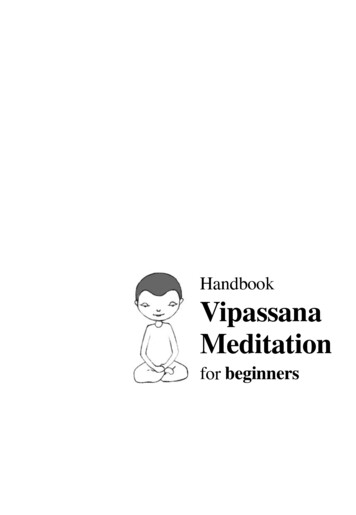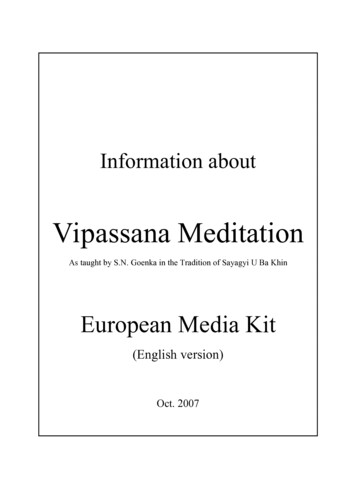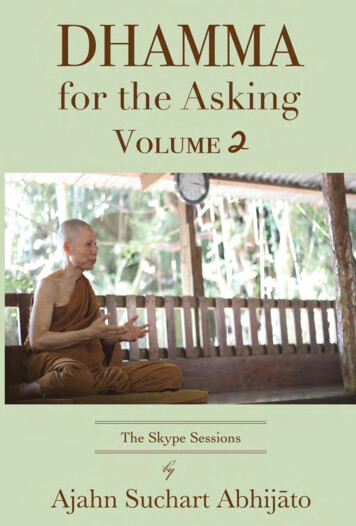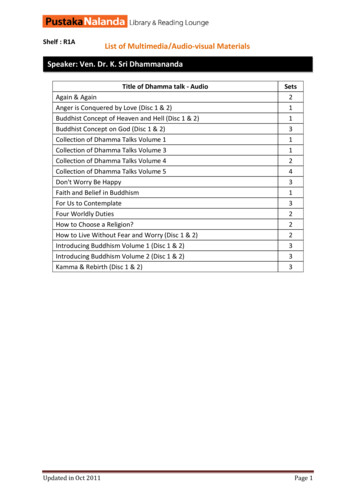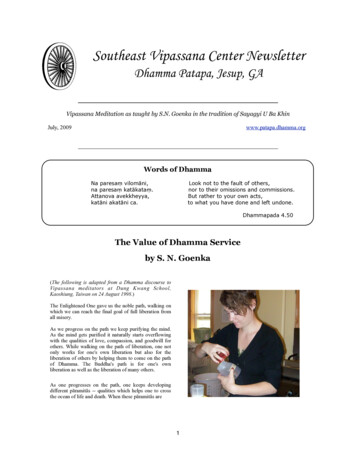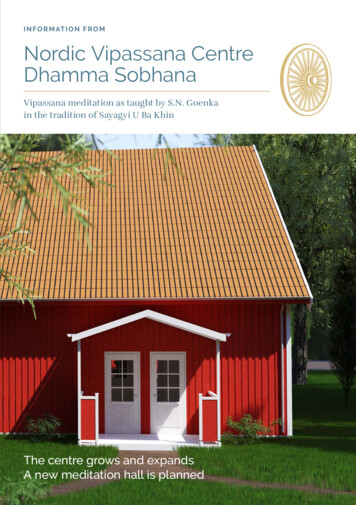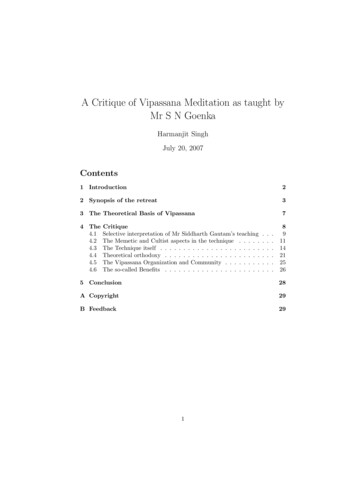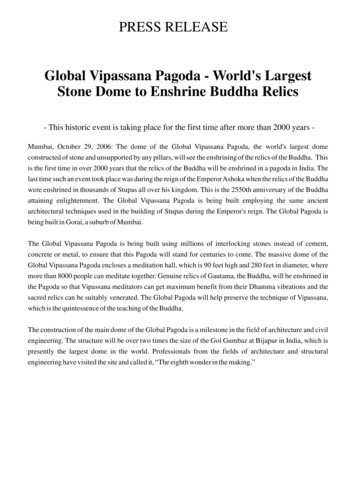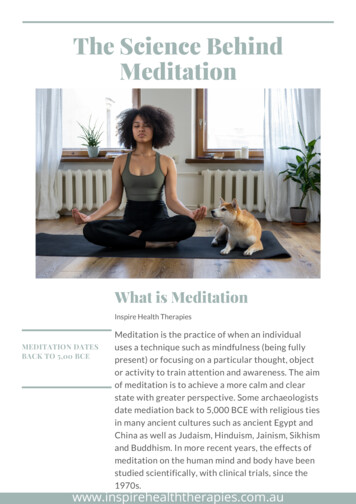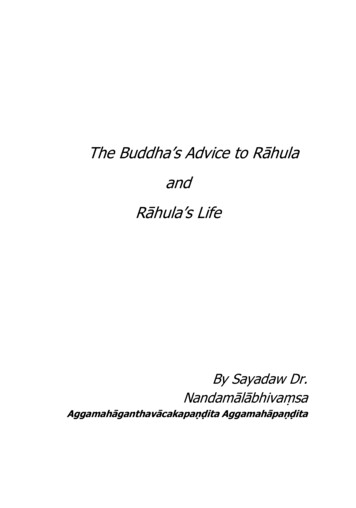
Transcription
Vipassana Meditationas taught by S. N. Goenka in the tradition of Sayagyi U Ba KhinIntroduction to the Technique and Code of Discipline forMeditation CoursesMay your meditation prove most beneficial to you. With best wishes for success, we offeryou the following information. Please read it carefully before applying for a course.Introduction to the TechniqueVipassana is one of India's most ancient meditation techniques. Long lost to humanity, it wasrediscovered by Gotama the Buddha more than 2500 years ago. Vipassana means seeingthings as they really are. It is the process of self-purification by self-observation. One beginsby observing the natural breath to concentrate the mind. With a sharpened awareness oneproceeds to observe the changing nature of body and mind, and experiences the universaltruths of impermanence, suffering and egolessness. This truth- realization by directexperience is the process of purification. The entire path (Dhamma) is a universal remedy foruniversal problems, and has nothing to do with any organized religion or sectarianism. Forthis reason, it can be practiced freely by everyone, at any time, in any place, without conflictdue to race, community or religion, and it will prove equally beneficial to one and all.What Vipassana is not: It is not a rite or ritual based on blind faith. It is neither an intellectual nor a philosophical entertainment. It is not a rest cure, a holiday, or an opportunity for socializing. It is not an escape from the trials and tribulations of everyday life.What Vipassana is: It is a technique that will eradicate suffering. It is a method of mental purification which allows one to face life's tensions andproblems in a calm, balanced way. It is an art of living that one can use to make positive contributions to society.Page 1 of 9www.khetta.dhamma.org
Vipassana meditation aims at the highest spiritual goals of total liberation and fullenlightenment; its purpose is never simply to cure physical disease. However, as a by-productof mental purification, many psychosomatic diseases are eradicated. In fact, Vipassanaeliminates the three causes of all unhappiness: craving, aversion and ignorance. Withcontinued practice, the meditation releases the tensions developed in everyday life, openingthe knots tied by the old habit of reacting in an unbalanced way to pleasant and unpleasantsituations.Although Vipassana was developed as a technique by the Buddha, its practice is notlimited to Buddhists. There is absolutely no question of conversion. All human beings sharethe same fundamental problems, and a technique which can eradicate these problems willhave a universal application. People from many religious denominations have experiencedthe benefits of Vipassana meditation, and have found no conflict with their profession offaith.Meditation and Self-disciplineThe process of self-purification by introspection is certainly never easy-students have towork very hard at it. By their own efforts students arrive at their own realizations; no oneelse can do this for them. Therefore, the meditation will suit only those willing to workseriously and observe the discipline, which is there for the benefit and protection of themeditators and is an integral part of the meditation practice.Ten days is certainly a very short time in which to penetrate the deepest levels of theunconscious mind and learn how to eradicate the complexes lying there. Continuity of thepractice in seclusion is the secret of this technique's success. Rules and regulations have beendeveloped keeping this practical aspect in mind. They are not primarily for the benefit of theteacher or the course management, nor are they negative expressions of tradition,orthodoxy or blind faith in some organized religion. Rather, they are based on the practicalexperience of thousands of meditators over the years, and are both scientific and rational.Abiding by the rules creates a very conducive atmosphere for meditation; breaking thempollutes it.Page 2 of 9www.khetta.dhamma.org
Students will have to stay for the entire period of the course. The other rules shouldalso be carefully read and considered. Only those who feel that they can honestly andscrupulously follow the discipline should apply for admission. Those not prepared to makea determined effort will waste their time and, moreover, will disturb others who wish towork seriously. A prospective student should also understand that it would be bothdisadvantageous and inadvisable to leave without finishing the course upon finding thediscipline too difficult. Likewise, it would be most unfortunate if, in spite of repeatedreminders, a student does not follow the rules and has to be asked to leave.Serious Mental DisordersPeople with serious mental disorders have occasionally come to Vipassana courses with theunrealistic expectation that the technique will cure or alleviate their mental problems.Unstable interpersonal relationships and a history of various treatments can be additionalfactors which make it difficult for such people to benefit from, or even complete, a ten-daycourse. Our capacity as a nonprofessional, volunteer organization makes it impossible for usto properly care for people with these backgrounds. Although Vipassana meditation isbeneficial for most people, it is not a substitute for medical or psychiatric treatment and wedo not recommend it for people with serious psychiatric disorders.The Code of DisciplineThe foundation of the practice is sila-moral conduct. Sila provides a basis for thedevelopment of samadhi-concentration of mind; and purification of the mind is achievedthrough panna-the wisdom of insight.The PreceptsAll who attend a Vipassana course must conscientiously undertake the following Five Preceptsfor the duration of the course:1.to abstain from killing any being,Page 3 of 9www.khetta.dhamma.org
2.to abstain from stealing,3.to abstain from all sexual activity,4.to abstain from telling lies,5.to abstain from all intoxicants.There are three additional precepts which old students (that is, those who havecompleted a course with S. N. Goenka or one of his assistant teachers) are expected to follow:6.to abstain from eating after midday,7.to abstain from sensual entertainment and bodily decoration,8.to abstain from using high or luxurious beds.Old students will observe the sixth precept by having only tea (without milk) or fruitjuice during the 5 p.m. break, whereas new students may have tea with milk and some fruit.The teacher may excuse an old student from observing this precept for health reasons. Theseventh and eighth precepts will be observed by all.Acceptance of the Teacher and the TechniqueStudents must declare themselves willing to comply fully and for the duration of the coursewith the teacher's guidance and instructions; that is, to observe the discipline and tomeditate exactly as the teacher asks, without ignoring any part of the instructions, noradding anything to them. This acceptance should be one of discrimination andunderstanding, not blind submission. Only with an attitude of trust can a student workdiligently and thoroughly. Such confidence in the teacher and the technique is essential forsuccess in meditation.Other Techniques, Rites, and Forms of WorshipDuring the course it is absolutely essential that all forms of prayer, worship, or religiousceremony-fasting, burning incense, counting beads, reciting mantras, singing and dancing,etc.-be discontinued. All other meditation techniques and healing or spiritual practicesshould also be suspended. This is not to condemn any other technique or practice, but togive a fair trial to the technique of Vipassana in its purity.Page 4 of 9www.khetta.dhamma.org
Students are strongly advised that deliberately mixing other techniques of meditationwith Vipassana will impede and even reverse their progress. Despite repeated warnings bythe teacher, there have been cases in the past where students have intentionally mixed thistechnique with a ritual or another practice, and have done themselves a great disservice. Anydoubts or confusion which may arise should always be clarified by meeting with the teacher.Interviews with the TeacherThe teacher is available to meet students privately between 12 noon and 1:00 p.m.Questions may also be asked in public between 9:00 and 9:30 p.m. in the meditation hall.The interview and question times are for clarifying the technique and for questions arisingfrom the evening discourses.Noble SilenceAll students must observe Noble Silence from the beginning of the course until the morningof the last full day. Noble Silence means silence of body, speech, and mind. Any form ofcommunication with fellow students, whether by gestures, sign language, written notes, etc.,is prohibited.Students may, however, speak with the teacher whenever necessary and they mayapproach the management with any problems related to food, accommodation, health, etc.But even these contacts should be kept to a minimum. Students should cultivate thefeeling that they are working in isolation.Separation of Men and WomenComplete separation of men and women is to be maintained. Couples, married or otherwise,should not contact each other in any way during the course. The same applies to friends,members of the same family, etc.Physical ContactIt is important that throughout the course students avoid any physical contact whatsoeverwith others of the same or opposite sex.Yoga and Physical ExerciseAlthough physical yoga and other exercises are compatible with Vipassana, they should bePage 5 of 9www.khetta.dhamma.org
suspended during the course because proper secluded facilities are not available at thecourse site. Jogging is also not permitted. Students may exercise during rest periods bywalking in the areas designated for men or for women.Religious Objects, Rosaries, Crystals, Talismans, etc.No such items should be brought to the course. If brought inadvertently, they must bedeposited with the management for the duration of the course.Intoxicants and DrugsNo drugs, alcohol, or other intoxicants should be brought to the site; this also applies totranquilizers, sleeping pills, and all other sedatives. Those taking medicines or drugs on adoctor's prescription should notify the teacher.TobaccoFor the health and comfort of all students, smoking, chewing tobacco, and taking snuff are notpermitted at the course.FoodIt is not possible to satisfy the special food preferences and requirements of individualmeditators. Students are therefore kindly requested to make do with the simple vegetarianmeals provided. The course management endeavors to prepare a wholesome, balancedmenu suitable for meditation, without subscribing to any particular food philosophy. If anystudents have been prescribed a special diet because of ill-health, they should inform themanagement at the time of application. Fasting is not permitted.ClothingDress should be simple, modest, and comfortable. Tight, transparent, revealing, or otherwisestriking clothing (such as shorts, short skirts, tights and leggings, sleeveless or skimpy tops)should not be worn. Sunbathing and partial nudity are not permitted. An attitude of modestyprevails at all times. This is important in order to minimize distraction to others.Page 6 of 9www.khetta.dhamma.org
Laundry and BathingNo washing machines or dryers are available, so students should bring sufficient clothing.Small items can be hand-washed. Bathing and laundry may be done only in the break periodsand not during meditation hours.Outside ContactsStudents must remain within the course boundaries throughout the course. They may leaveonly with the specific consent of the teacher. No outside communication is allowed beforethe course is completely over. This includes letters, phone calls and visitors. Cell phones,pagers, and other electronic devices must be deposited with the management until thecourse ends. In case of an emergency, a friend or relative may contact the management.Music, Reading and WritingThe playing of musical instruments, radios, etc., is not permitted. No reading or writingmaterials should be brought to the course. Students should not distract themselves by takingnotes. The restriction on reading and writing is to emphasize the strictly practical nature ofthis meditation.Tape Recorders and CamerasThese may not be used except with the express permission of the teacher.Course FinancesAccording to the tradition of pure Vipassana, courses are run solely on a donation basis.Donations are accepted only from those who have completed at least one ten-day coursewith S.N. Goenka or one of his assisting teachers. Someone taking the course for the firsttime may give a donation on the last day of the course or any time thereafter.In this way, courses are supported by those who have realized for themselves thebenefits of the practice. Wishing to share these benefits with others, one gives a donationaccording to one's means and volition.Such donations are the only source of funding for courses in this tradition around thePage 7 of 9www.khetta.dhamma.org
world. There is no wealthy foundation or individual sponsoring them. Neither the teachersnor the organizers receive any kind of payment for their service. Thus, the spread ofVipassana is carried out with purity of purpose, free from any commercialism.Whether a donation is large or small, it should be given with the wish to help others:"The course I have taken has been paid for through the generosity of past students; now letme give something towards the cost of a future course, so that others may also benefit fromthis technique."SummaryTo clarify the spirit behind the discipline and rules, they may be summarized as follows:Take great care that your actions do not disturb anyone. Take no notice of distractionscaused by others.It may be that a student cannot understand the practical reasons for one or several ofthe above rules. Rather than allow negativity and doubt to develop, immediate clarificationshould be sought from the teacher.It is only by taking a disciplined approach and by making maximum effort that a studentcan fully grasp the practice and benefit from it. The emphasis during the course is on work. Agolden rule is to meditate as if one were alone, with one's mind turned inward, ignoring anyinconveniences and distractions that one may encounter.Finally, students should note that their progress in Vipassana depends solely on theirown good qualities and personal development, and on five factors: earnest efforts,confidence, sincerity, health and wisdom.May the above information help you to obtain maximum benefit from your meditationcourse. We are happy to have the opportunity to serve, and wish you peace and harmonyfrom your experience of Vipassana.Page 8 of 9www.khetta.dhamma.org
The TimetableThe following timetable for the course has been designed to maintain the continuity ofpractice. For best results,students are advised to follow it as closely as possible.4:00 amMorning wake-up bell4:30-6:30 amMeditate in the hall or in your room6:30-8:00 amBreakfast break8:00-9:00 amGroup meditation in the hall9:00-11:00 amMeditate in the hall or in your room according to theteacher's instructions11:00-12:00 noonLunch break12noon-1:00 pmRest and interviews with the teacher1:00-2:30 pmMeditate in the hall or in your room2:30-3:30 pmGroup meditation in the hall3:30-5:00 pmMeditate in the hall or in your own room according to theteacher's instructions5:00-6:00 pmTea break6:00-7:00 pmGroup meditation in the hall7:00-8:15 pmDiscourse in the hall8:15-9:00 pmGroup meditation in the hall9:00-9:30 pmQuestion time in the hall9:30 pmRetire to your own room--Lights outPage 9 of 9www.khetta.dhamma.org
Vipassana Meditation as taught by S. N. Goenka in the tradition of Sayagyi U Ba Khin Introduction to the Technique and Code of Discipline for Meditation Courses May your meditation prove most beneficial to you. With best wishes for success, we offer you the following information. Please read it carefully before applying for a course.
